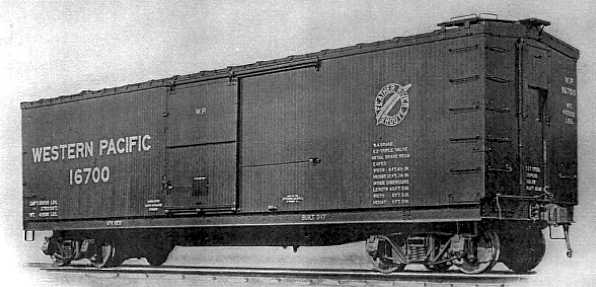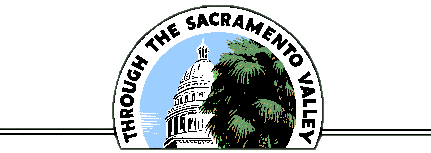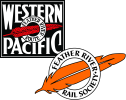SACRAMENTO NORTHERN'S STEEL-UNDERFRAME BOXCARS
Sacramento Northern's 2329-series boxcars served the railroad for almost 50 years, along with similar cars in the 2301-series purchased later from the Western Pacific. With their graceful arched lettering, wooden sides, and upright brake wheels, they were relics of an earlier time, and were popular photo subjects with railfans.
The story of these interesting boxcars begins not on the SN, but with the WP. In 1917 the WP began to acquire a modest fleet of steel underframe boxcars from the Mount Vernon Car Manufacturing Company. These were 40 feet long inside, with an eight-foot inside height, and a capacity of 2723 cubic feet. They were sheathed in wood on both the sides and ends, had Queenan or Murphy galvanized iron roofs, and were equipped with K-brakes and arch bar trucks. The first group of these cars was numbered 16001-16800. They were followed in 1918 by numbers 16801-18300, nearly identical except for a brake staff seven inches taller. A third series was also delivered in 1918, 30001-30200. They were similar to the other two groups, except they were built as ventilator cars with grilled openings for air circulation.

The WP was not content for long with their Mount Vernon cars, and began rebuilding the ventilators into plain boxcars by 1927. The rebuilt cars were given steel ends, a two-piece inverse Murphy or Dreadnaught design with a small lumber door in the A end. Capacity jumped to 2742 cubic feet. The rebuilt cars were renumbered into the 18301-18500 series. By 1929, the plain boxcars were also being rebuilt, using their original numbers. Most of the later rebuilds received inverse Dreadnaught ends. Where needed, they were given Murphy pivoting flexible roofs. The project was done by 1931, with all three classes lumped together into numbers 16001-18500.
There were later changes to the WP cars, including Andrews trucks during the 1930s. For some reason a few cars were not converted, and were renumbered into series 316001-318500. In 1940 there were 152 cars in this group. Their obsolete arch bar trucks made them illegal for interchange after 1941. A dwindling number of the arch bar-equipped cars continued to serve in restricted service throughout World War II and beyond. The last of this subclass disappeared from the WP in the early 1950s. The later history of the remaining WP cars in the 16001-series does not concern us here, except to say that a handful continued to serve into the late 1960s.
In 1918, the newly reorganized Sacramento Northern Railroad inherited a fleet of obsolete 36-foot boxcars with truss rods and wooden underframes from the bankrupt Northern Electric Railway. The railroad needed more modern cars, so in 1919 they bought 25 new boxcars from Mount Vernon. It is unclear whether these were a follow-on to the WP orders, or simply used the same plans. In any case, they were nearly identical to the original WP plain boxcars. SN 2129-2153 were delivered in late 1919 and into early 1920. Unlike the WP cars, the SN copies never received steel ends.

After wooden underframes were banned from interchange in 1928, the 2129-series were the only SN cars allowed to go off-line (plus SN 2100, a lone 36-foot auto boxcar which also had a steel underframe). SNRR 2149 was off the roster before 1925, probably due to wreck damage. SNRY 2131 and 2133 were lost to a fire at Haggin Yard in 1931. After 1941, this class use was restricted by their arch bar trucks. Since the SN was by then a wholly-owned WP subsidiary, they still could be be used on the parent road, and on the Tidewater Southern. They were frequently used for LCL freight on the SN, and one was almost always seen behind the electric locomotives on trains through the Oakland Hills. This service ended in the 1950s.
In 1947, the SN bought 28 "new" boxcars from the WP. These were Mount Vernon cars rebuilt with steel ends, mostly Dreadnaught, though one Murphy-end car was in the lot, SN 2301. The entire group came from WP series 316001-318500, the cars which never had their arch bar trucks replaced with Andrews in the 1930s. Some of the ex-WP cars were originally the ventilators which had been rebuilt prior to 1930. They were renumbered SN 2301-2328. There are photos which show these cars with hastily painted SN reporting marks, but with the WP herald still on the doors. Eventually all were repainted with the graceful arched lettering used on other SN wooden boxcars. Many early photos show a reweigh date of 1948 on these cars, indicating that there was some delay after delivery before they went into service. Possibly the delay was to equip the cars with AB brakes, as your author has seen no documentation of a later refit.
The surviving 22 cars in SN series 2129-2153 were retired when the ex-WP cars arrived. And here the story gets very interesting. Authorization for Expenditure (AFE) 1-47 claims they were retired and scrapped. In reality they were simply pushed off onto sidings to await disposal. And there they sat for a year. Then in 1948, the entire group was "unretired". They were shopped, given AB brakes, and returned to service as SN 2329-2350.

Early in 1955, most cars in both the 2301 and 2329 series received Andrews trucks in place of their arch bars. After car ferry Ramon was taken out of service, cars moving between the two now-disjointed ends of the SN had to use trackage rights over the Santa Fe between Stockton and Pittsburg, and arch bar trucks would not have been allowed there. No conversion records for the boxcars have so far surfaced, though photos show that many of the cars were reweighed in early 1955. A reweigh would have been required because of the heavier Andrews trucks. A few of the boxcars were never converted and continued to roll on arch bar trucks into the 1970s.
Downgrading the wooden boxcars had already begun by the mid-1950s. SN 2339, 2338, 2349 and 2313, were transferred to maintenance-of-way service as MW 90-93 in 1954. Others soon followed, but as late as 1959 there were still 24 cars in the 2301 series, and 19 in the 2329 series. In late 1959 and early 1960, 19 cars were sold for scrap to F. L. Botsford. A few cars were retired due to wreck damage, and several more were scrapped in 1963. In June 1964, 2301, 2302, 2310, 2312, 2314, 2320, 2335, and 2343-2346 were reassigned to company service. The SN no longer used special numbers for maintenance equipment after 1954, but simply painted "MW 0 [zero]" in front of the car number. Eventually this lettering change was dropped, and based on photographs, some cars were used for maintenance service without being renumbered. A few more cars were retired during the late 1960s, but surprisingly, 2326, 2337 and 2350 were still on the revenue freight roster in 1969, though whether they saw much actual service is debatable.

All the remaining Mount Vernon cars were sold off in the early-1970s. The last car retired was MW 02335 in January 1976, which for years was assigned to Yuba City. It became a gift shop in Yountville. Five cars went to a shopping development in Alameda known as "The Factory" for use as boutiques (MW 92, MW 02302, MW 02312, 2326, and 2313, the latter hastily relettered back from MW 93). When this venture failed, the cars were scattered, and three were lost. MW 02302 became property of an East Bay railfan, and was eventually donated to the Pacific Locomotive Association for preservation on their Niles Canyon Railway at Sunol. The Fillmore & Western uses 2326 in its movie train. Other survivors include 2310 in use as a shed near Diamond Springs, 2314 at the Western Railway Museum at Rio Vista Junction, 2346 at the Portola Railroad Museum, and 2350 at the California State Railway Museum in Sacramento. SN 2350 now rides on arch bar trucks that came from 2313 when that car was junked after The Factory failed. The CSRM also owns an ex-WP steel-end car later used by the Stockton Terminal & Eastern (neither are currently on display).


